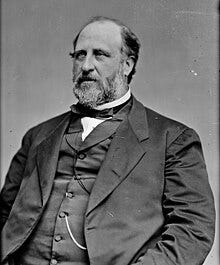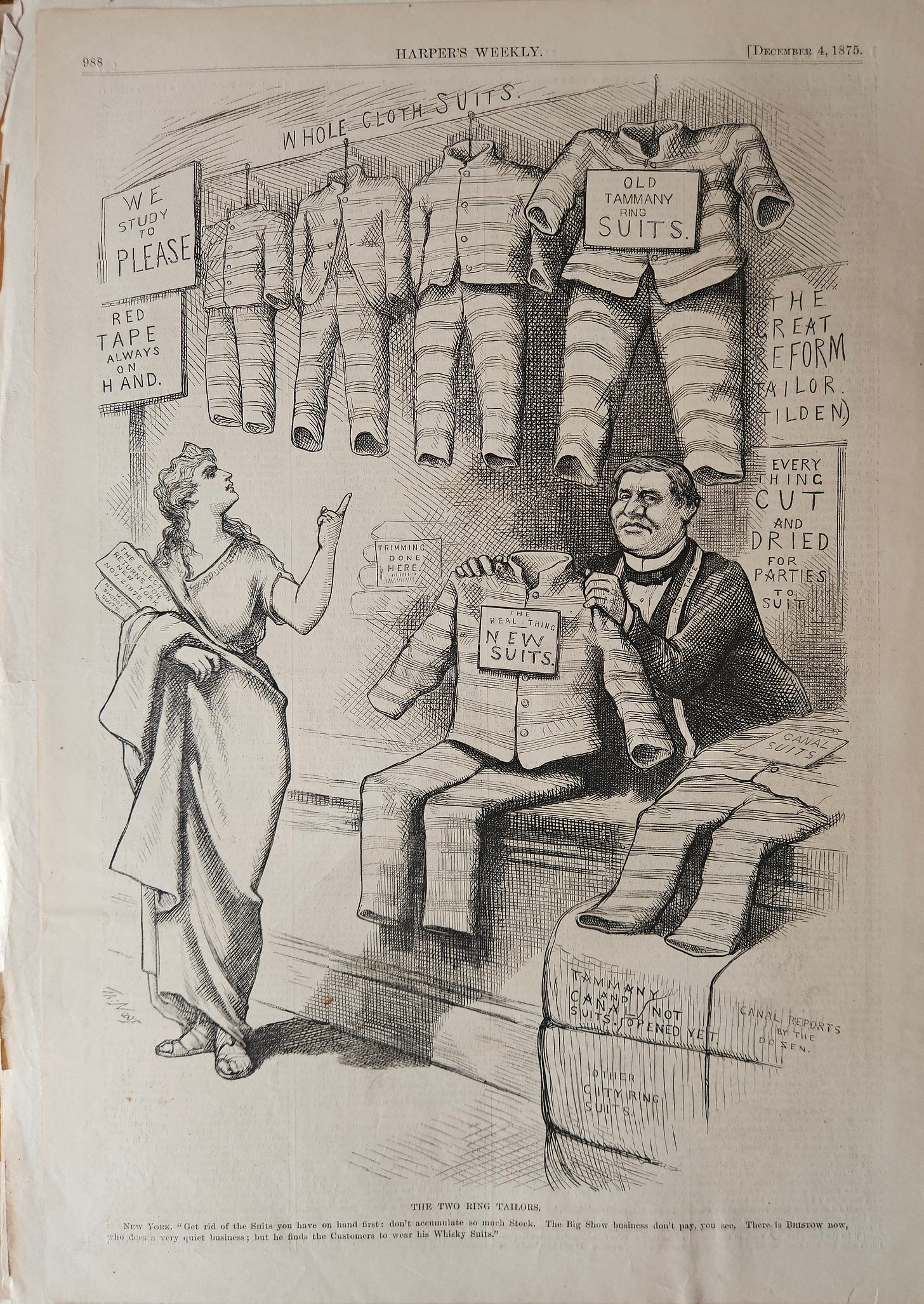TAMMANY 'SUITS'--Here's the full story of Boss Tweed & his theft of millions (BILLIONS in today's dollars) from NYC taxpayers, and the final outcome in 1878.
https://en.wikipedia.org/wiki/William_M._Tweed
Nast drew a score of political cartoons, the most famous of which were published in Harper's Weekly and exposed the illegal dealings of Tammany Hall, a political machine in New York City headed by politician William M. Tweed. (This one from November 13, 1875).
THE ELECTIVE SYSTEM : OR, MASTER AND SLAVE
Nast suggests that even though Tweed was in jail, he was not treated the same as the less connected prisoners. While he stands around, well-fed and smoking cigars, other inmates are immobilized and denied necessities.
(Words in small print, above seated inmate, explained below)
The refrain, “What are you going to do about it?” is a taunt that originated with Tweed when he was at the height of his power as the head of Tammany Hall and was openly stealing from the public treasury. Nast includes the refrain in many of his cartoons satirizing Tweed.
(DO YOU RECOGNIZE BOSS TWEED in the drawing? REMEMBER WHAT HE SAID ABOUT NAST (from my yesterday’s post, 7/20/24)? Here it is again:
Regarding Nast's cartoons, Tweed reportedly said, "Stop them damned pictures. I don't care so much what the papers say about me. My constituents don't know how to read, but they can't help seeing them damned pictures!
———-
(From Wikipedia)
WILLIAM MAGEAR TWEED (1823-1878), often erroneously referred to as "William Marcy Tweed", and widely known as "Boss" Tweed, was an American politician most notable for being the "boss" of Tammany Hall, the Democratic Party political machine that played a major role in the politics of 19th-century NYC and State. At the height of his influence, Tweed was the third-largest landowner in NYC, a director of the Erie Railroad, a director of the Tenth National Bank, a director of the New-York Printing Company, the proprietor of the Metropolitan Hotel, a significant stockholder in iron mines and gas companies, a board member of the Harlem Gas Light Company, a board member of the Third Avenue Railway Company, a board member of the Brooklyn Bridge Company, and the president of the Guardian Savings Bank. Tweed was elected to the New York County Board of Supervisors in 1858, the year that he became the head of the Tammany Hall political machine. He was also elected to the New York State Senate in 1867, but Tweed's greatest influence came from being an appointed member of a number of boards and commissions, his control over political patronage in New York City through Tammany, and his ability to ensure the loyalty of voters through jobs he could create and dispense on city-related projects. Tweed had for months been under attack from "The New York Times" and Thomas Nast, the cartoonist from "Harper's Weekly." Regarding Nast's cartoons, Tweed reportedly said, "Stop them damned pictures. I don't care so much what the papers say about me. My constituents don't know how to read, but they can't help seeing them damned pictures! Tweed was finally convicted for stealing an amount estimated by an aldermen's committee in 1877 at between $25 million and $45 million from NYC taxpayers from political corruption, but later estimates ranged as high as $200 million. Unable to make bail, he escaped from jail & tried to flee to Spain. The government alerted the Spanish & ironically he was arrested by Spanish police using one of Nast's cartoon pictures for identification, as he stepped off the boat. He was returned to custody & died in the NYC Ludlow Street Jail."
As a crusading civil reformer Nast helped destroy the corrupt "Boss" Tweed Ring that swindled NYC of millions of dollars. His impact on American public life was formidable enough to profoundly affect the outcome of every presidential election during the period 1864 to 1884.
William Magear "Boss" Tweed
————-
(From Digital Exhibits)
Using his connections as a member of boards and commissions in New York City, Tweed exerted enormous control over the city through the creation of city-related projects and jobs. The Nast vs. Tweed campaign began in 1870 with sporadic cartoons satirizing Tammany Hall and Tweed's campaign for the New York State Senate during the 1871 November elections. By August 1871, the cartoons came on a weekly basis, and each cartoon was more pointed than the previous one.
Readers in New York followed the campaign closely, especially as economic conditions deteriorated.
In 1871, city workers were denied their wages because the city did not have enough money to pay salaries. On September 30, 1871, there was a strike and a riot. In October of 1871, Nast used the escalating economic tensions to critique the Tammany Hall ringleaders, suggesting that they were responsible for stealing the workers' wages. The cartoon's caption pointedly asks voters, "What are you going to do about it?"
Despite Nast's campaign against Tweed and the Tammany Hall ring, Tweed was re-elected to the New York State Senate. There were enough opposition candidates (from both parties), however, that an effective investigation of Tweed could be accomplished, ultimately resulting in a conviction.
Tweed appealed the conviction, and in June of 1875 it was overturned. Tweed was released from Blackwell’s Island Penitentiary on June 21 at midnight. He had dinner at Delmonico’s Steakhouse. Then he was remanded to the Ludlow Street Jail to face more charges that were filed against him.
At the time that this cartoon was published, Tweed was still in jail facing numerous civil suits. (see Nast illustration of “Suits” below)
.————
(FROM WIKIPEDIA)
William Magear "Boss" Tweed (April 3, 1823 – April 12, 1878) was an American politician most notable for being the political boss of Tammany Hall, the Democratic Party's political machine that played a major role in the politics of 19th-century New York City and State.
Tweed was elected to the United States House of Representatives in 1852 and the New York County Board of Supervisors in 1858, the year that he became the head of the Tammany Hall political machine. He was also elected to the New York State Senate in 1867. However, Tweed's greatest influence came from being an appointed member of a number of boards and commissions, his control over political patronage in New York City through Tammany, and his ability to ensure the loyalty of voters through jobs he could create and dispense on city-related projects.
Tweed's first trial before Judge Noah Davis,[38] in January 1873, ended when the jury was unable to deliver a verdict. Tweed's defense counsel included David Dudley Field II and Elihu Root.[39] His retrial, again before Judge Noah Davis in November resulted in convictions on 204 of 220 counts, a fine of $12,750[5] (the equivalent of $320,000 today) and a prison sentence of 12 years; a higher court, however, reduced Tweed's sentence to one year.[40] After his release from The Tombs prison, New York State filed a civil suit against Tweed, attempting to recover $6 million in embezzled funds.[4Unable to put up the $3 million bail, Tweed was locked up in the Ludlow Street Jail, although he was allowed home visits.
“THE TWO RING TAILORS.” DECEMBER 4, 1875—same date that Tweed fled to Spain! (see below).
During one of these visits home visits from Ludlow Street Jail, on December 4, 1875, Tweed escaped and fled to Spain,[41] where he worked as a common seaman on a Spanish ship.[34] The U.S. government discovered his whereabouts and arranged for his arrest once he reached the Spanish border, where he was recognized from Nast's political cartoons.
Tweed was convicted for stealing an amount estimated by an aldermen's committee in 1877 at between $25 million and $45 million from New York City taxpayers from political corruption, but later estimates ranged as high as $200 million (equivalent to $5 billion in 2023).[4] Unable to make bail, he escaped from jail once but was returned to custody.
He was turned over to an American warship,[34] the USS Franklin, which delivered him to authorities in New York City on November 23, 1876, and he was returned to prison.[19][42]
Desperate and broken, Tweed now agreed to testify about the inner workings of the Tweed Ring to a special committee set up by the Board of Aldermen[5] in return for his release, but after he did so, Tilden, now governor of New York, refused to abide by the agreement, and Tweed remained incarcerated.
He died in the Ludlow Street Jail on April 12, 1878, from severe pneumonia, and was buried in Brooklyn's Green-Wood Cemetery.[43] Mayor Smith Ely would not allow the flag at City Hall to be flown at half staff.[5]
———-
(More from Digital Exhibits)
Thomas Nast is one of the most influential cartoonists in American history and is often called the "Father of the American Cartoon." Born in Germany, he immigrated to the United States at the age of 6; by age 15, he had begun drawing for Leslie's Illustrated Newspaper. Today, Nast is best remembered for creating the modern image of Santa Claus and the Republican elephant, and popularizing the Democratic donkey through his iconic illustrations.
————







Hmmm. I wonder if Boss T was a role model for our current wannabe Boss T. :-)
I'm proud to say I am a descendant of Judge Noah Davis, he is my 3rd great grandfather.